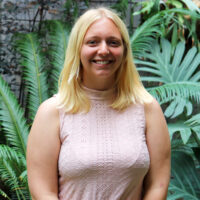
Investigation of the negative correlation between carotenoid andstarch levels in the leaves of Arabidopsis thaliana
Carotenoids serve as provitamin A compounds and dietary antioxidants in humans and are important photosynthesis pigments, photoprotective agents, flavor/aroma compounds, precursors of phytohormones, and signaling molecules in plants (Milani et al., 2017). Phytoene synthase (PSY), is the rate-determining enzyme dictating carotenoid biosynthesis. Previously conducted research revealed transgenic crops overexpressing PSY resulted in high amounts of provitamin A carotenoid synthesis (Paine et al., 2005). Starch is the most important carbohydrate used for food and represents a main source of energy in the human diet (Warren et al., 2018). As major staple crops are composed mainly of carbohydrates such as starch, starch content directly affects crop yield. Amyloplasts, plastids that store starch, also partake in the carotenoid biosynthesis pathway (Sun et al., 2018). Since major crops have become less nutritious over time and are poor sources of micronutrients (Gaikwad et al., 2020), it is critically important to enhance crop nutritional value without yield penalty. However, previous studies have shown that there is a negative correlation between the amount of carotenoids and the amount of starch present in plants (Trono, 2019). This project investigated further the negative correlation with the ultimate goal of finding what causes such a negative correlation. Transgenic Arabidopsis overexpressing the PSY gene with increased carotenoid biosynthesis was used in this study along with Col-0 wild type and AtPSY mutant. The negative correlation between carotenoid and starch accumulation was shown through a time-course study held from 0900 through 2100. Plants were stained with lugol’s solution to examine the relative abundance of starch and carotenoid extractions were completed. RNA sequencing resulted in selecting 5 candidate genes that could be responsible for the negative correlation: amylase alpha 1 (AMY1), phosphoglucan water dikinase (GWD2), alkaline/neutral invertase B (A/N-INVB), beta-amylase 5 (BAM5), and granule-bound starch synthase 1 (GBSS1). Future work will be done to analyze the amount of the selected genes present in the plants through qRT-PC. Results of the findings can facilitate the generation of crops that can be genetically modified to have high starch content with a high yield and still be higher in carotenoids with a richer nutritional value.
I can gladly say I learned a lot over the course of this summer; learned more lab skills than I thought I would and grew as a person so much more. This experience has given me confidence in being an efficient laboratory researcher and science communicator. One highlight of my summer was creating an educational scientific video about transgenic plants with Science IRL. It is amazing thinking about how what scientists are doing in labs have the ability to get to the general public quickly through videos and social media. I had a lot of variety in laboratory techniques through my summer projects, some of which I had no previous experience doing. I was able to not only learn those, but while my plants were growing at the start of the summer I helped my mentor with a different project involving an entirely different set of skills. I learned to be a better troubleshooter, better data analysis, and plan my tasks for each day. I was able to create progress presentations and present them in front of my lab, which increased my presentation skills. Through weekly seminars I was able to be exposed to many different types of research being conducted on plants, which helped me gain a better understanding on the specific type of research I want to do for my graduate studies. This summer shed light on what earning a PhD would be like, and I am glad I am still looking forward to the day I get accepted into a program and walk across the stage with my doctorate degree in hand.
